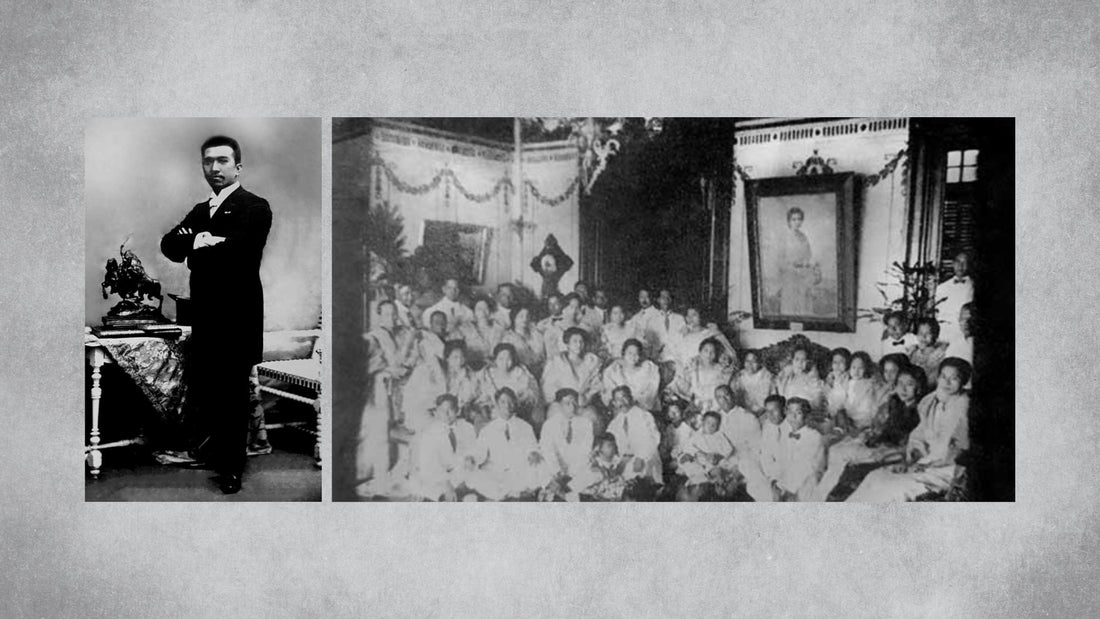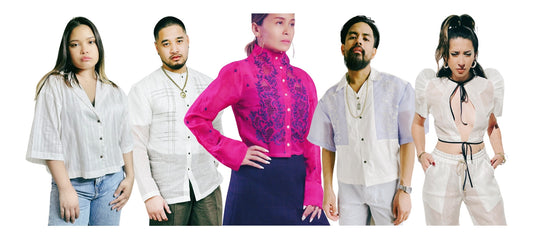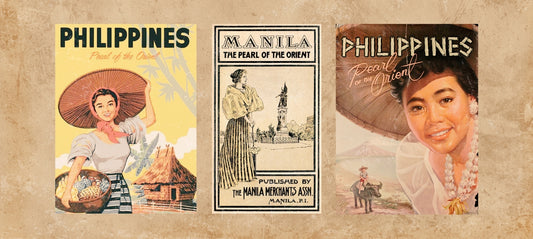By Danica Hooper, Guest Writer for VINTA Gallery
The House of Limjap began with Lim Cong Jap, a Chinese immigrant from Amoy (now Xiemen), in the 19th century. The tales of his journey to the Philippines is one of legends; one particular story that stuck in VINTA Gallery Founder, Creative Director, and Limjap descendent, Caroline Mangosing’s mind is that Lim Cong Jap snuck into a trading ship going from Amoy to Manila. Another tells the tale of a young Lim Cong Jap travelling with a British merchant and through this experience, he was able to afford a ticket to his new life in the Philippines. The details of his journey have long been lost, but one true thing remains: Lim Cong Jap was the founder of one of Manila’s notable Chinese mestizo families.
After arriving in Manila Bay, he quickly made connections with other Chinese immigrants tied to trading businesses, as well as those with local businesses in Manila. At the time, Manila Bay was beautiful, surrounded by unpolluted rivers and forested mountains that you could see through the clean air–imagine that! “There are few bays in the world that are as beautiful as Manila’s,” Lafond de Lurcy wrote. Manila being named the Pearl of the Orient was so real. The Chinese community in Manila was a tight unit who protected and supported their own. This community-led mindset always stuck with Lim Cong Jap, and through this support, he was able to start his own trading business.
In the 19th century, Spain still ruled the Philippines and they wanted to convert Chinese people in the Philippines in the hopes of establishing a Catholic population in China (weren’t they just so persistent? *eye roll*). Because of this, Lim Cong Jap was baptised and as a newly Christianised Chinese Filipino, he changed his name “to sound more Spanish.” He adopted the name Joaquin Barrera Limjap–combining “Lim” and “Jap” (pronounced “Hap”) and removed the “Cong” as it “sounded too Chinese.” The name “Joaquin Barrera” is believed to have come from his godfather whose name he took, as many baptised people frequently did at the time. After his baptism, Joaquin Barrera Limjap was able to marry a Christian mestiza, as Chinese women who lived in the Philippines weren’t allowed to marry those from different cultures and religions. The Christianised Chinese were also given extra privileges from the Spanish government. For example, when they deemed that the Chinese population was becoming too large, they would deport non-Christians back to China–those who were Christians were allowed to stay (uhhh… what the actual hell?).
By the mid-19th century, the Chinese controlled much of the business sector by exporting products such as rice, tobacco, cotton, mahogany, and indigo, to name a few. They began their own trading firms and through this, monopolised commodities trading. Joaquin took advantage of this rise and began exporting hemp, the Philippines’ largest export crop in the 19th century. He expanded to include sugar and tobacco. Joaquin eventually founded his own trading firm, Siu Long Company and became one of the most successful and influential businessmen in his community and established the House of Limjap as a prominent Chinese mestizo family.
Joaquin and his wife Policarpia Nolasco had three sons, Mariano, Jacinto, and Apolonio.

When Joaquin died in January 1888, Mariano, 19 at the time, became the head of the household and with his inheritance started his own trading firm in February or March of 1888. He expanded to Iloilo and began trading internationally by 1890. He was involved in many other lucrative businesses and investments, such as becoming a member of the Board of Directors of Bank of the Philippine Islands, helping found San Miguel Corporation, Filipinas Compania de Seguros, China Banking Corporation, and Ayala’s FGU Group. He may have also been an investor of the Hong Kong and Shanghai Banking Corporation. Mariano also bought rice plantations and rice mills, which were later left to his sons. Needless to say, he became one of the top and influential business leaders in the nation.
Not only was Mariano a successful businessman, he was also a financier of La Liga Filipina, founded by Jose Rizal in 1892 as part of the Propaganda Movement against Spanish rule in the Philippines. His support of La Liga led him to being arrested by Spanish authorities, alongside his brother Jacinto, during the “Spanish Reign of Terror” in 1896 where members and supporters of La Liga Filipina were arrested by the hundreds. He was released 6 months later in 1897 after Jose Rizal’s execution on December 31st, 1896.
During a very short period of “peace” after the Philippines’ independence from 300 years of Spanish colonisation, Mariano co-founded the Club Filipino Independiente in 1898, which was more of a political statement rather than a social club. Before this, the word “Filipino” was used only for Philippine-born Spaniards, so by claiming the word “Filipino” by non-Spanish mestizos and Indios (the name used for native Filipinos at the time), it was a big fuck you to our colonisers. Other founders of the Club Filipino Independiente include those who were arrested alongside Mariano and Jacinto. The Club’s inaugural ball was the first major social event that supporters of the revolution held together. It was a celebration of freedom and became one of the grandest affairs in Philippine history. But little did Mariano and all Filipinos know, that moment of peace would end so soon because guess what? After America helped the Philippines gain freedom from Spain, they decided to colonise us! The Philippine-American War began in 1899 and Club Filipino members were among the first to rally around Emilio Aguinaldo, the first president of the New Republic and leader of the Philippine-American War against the United States.

Mariano played a crucial role in the Philippine-American War as a close ally to Emilio Aguinaldo. He was named to a high-level finance committee, alongside two other men, who were authorised to sign paper currency. Jacinto became a tax collector in Manila and even though non-Spanish citizens had felt burdened by Spanish taxation, they freely gave to the rebel forces and the new government, so additional voluntary war tax was collected. In Caroline’s family whisperings, it is believed that Mariano funnelled some of his own money through BPI to fund the resistance. Now THAT is how you use your money for good! He was also appointed Inspector General of the Railroad for the Manila-Dagupan Railway, which transported troops, supplies, and government officials to Malolos, Tarlac, and Pangasinan. Control of the Manila-Dagupan Railway was extremely crucial during this time of war.
On June 21, 1899, Mariano became one of the new members of Congress when the Revolutionary Government transferred to Tarlac. He was assigned to succeed those who weren’t able to reach Tarlac in time to attend sessions due to capture or surrender. He was the only representative of the Tarlac Congress from Manila when there were previously four. In October of that same year, the Americans made plans for Aguinaldo’s capture in hopes for the surrender of the Revolutionary Government. Mariano’s biggest task as General of the Railroad was to provide safe passage and more time for President Aguinaldo, Revolutionary Government officials, and military forces to escape once reaching Pangasinan. He did so by destroying the railroad behind them in order to delay American forces. Yeah, you read that right–he blew up a railroad in order to serve his country.
Mariano was imprisoned by the colonial American government for his part in the resistance and call for reform. Although the new Philippine Government had lost the war, it is worth noting that at the time America was just becoming a world leader, therefore the Philippines was the first nation to fight this new power.
Once released, Mariano and the rest of the Limjaps who went into hiding in the mountains, returned to Manila. He continued to give scholarships to students in need, as well as host grandiose parties; the dichotomy of it all. His deep devotion to his country and community is not lost on the Limjap descendants. It just goes to show, you can use your money for good.

Now before you start throwing rocks and claiming generational wealth, it’s worth mentioning that the branch of the Limjap family that Caroline comes from, had already lost their fortune before Caroline could even inherit anything (much to her dismay). The only comparable thing to Mariano and his descendant Caroline is their business savvy and rebelliousness. Even though VINTA Gallery isn’t a major player in politics (and we wouldn’t want to be tbh), it is still built upon that devotion to community and revolution, and that culture is political in the imperial system we exist in. We are a small fashion company, but we've got things to say and we’re always doing everything in our own power to rebel against our oppressors, the way Mariano did all he could to take down an imperialist government.
If there’s one thing you take away from this, let it be understanding that the way you use your money means something. It’s possible to use your money for good. Use your buying power to build up businesses you believe in. After all, shopping small businesses is a revolutionary practice.

--- ---
About the Author:
Danica Hooper (she/her) is VINTA Gallery’s Social Media and Events Manager, as well as a multidisciplinary artist located in Toronto, Canada. She graduated from Toronto Metropolitan University (formerly Ryerson University) with a degree in Fashion Communications. Having moved to Toronto from the Philippines for university, she has always aimed to represent her culture and the beauty of her homeland by self-decolonizing and interacting and surrounding herself with decolonized art. Now that she has become a child of the diaspora, it is even more paramount to her that she remembers her roots through a decolonized lens.
Sources








